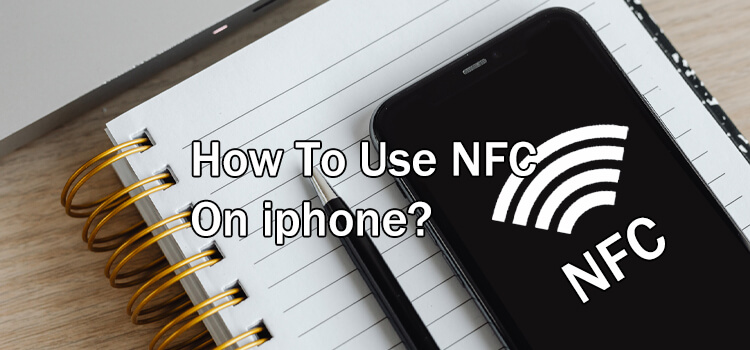All newer versions of the iPhone have been equipped with Near Field Communication (NFC) chips. If you own an iPhone 6 and above, you’ll be able to enjoy the benefits of this technology.
But how do you use NFC technology on iPhone? This article elucidates everything you need to know about the tech, its application, pros, and cons. Read on.
What is NFC Technology on iPhone?
NFC or Near Field Communication is a set of communication protocols by which different electronic devices can be coupled together by bringing them into physical proximity with one another.
The iPhone uses the NFC chip to communicate with other smartphones that are equipped with the same feature. It can also be used for making payments and accessing information at places like museums and galleries.
Which iPhones are NFC-enabled?
All iPhone models released since the iPhone 6 have NFC chips. However, most of the iPhone 6 versions only offer read NFC options.
All other versions offer read/write capabilities on NFC tags. What this means is that you can use your iPhone to read NFC tags that contain information, but you can also save any new information that you find on an NFC tag.
How do I Enable the NFC on iPhone?
Unlike NFC for Android, you do not need to switch NFC on/off on your iPhone. The iOS automatically detects that there is NFC in the vicinity and provides the corresponding functionality.
To put it simply, NFC in iPhones will respond based on your needs. If you open Apple Pay, it will automatically start the NFC functionality. This goes for any other application that wants to use NFC.
If you must activate NFC manually for reading an external tag, then follow the following step-by-step guide:
- Navigate to Settings and locate the Control Center
- Scroll through all the options until you find the NFC tag reader option
- Drag and drop it into your Control Center
- Navigate to your home screen and launch the control center (you can swipe down, up, or sideways depending on your model)
You can always launch your NFC Tag reader from the Control Center whenever you want to use it.
How to use NFC on iPhone?
You can use NFC on iPhone in two ways:
- As a tag
- As a reader
Using NFC on iPhone as a Tag
This is the most common application of NFC tags. I would guess that most of us have done this multiple times without even realizing it.
This is the primary technique used with contactless payment such as Apple Pay. The chip contains information that will help in authenticating your request.
Immediately your details are confirmed, the data will be sent to your linked credit card and the accurate amount will be deducted from your account.
Additionally, this approach is useful during data exchange. When you want to send data to another device, your tag will be read by the other device. When this happens, it will be excited and release the data for transfer. This process takes seconds!
Whenever there is an exchange of information, one device acts as the reader while the other is the tag in the NFC data transfer system.
Using NFC on iPhone as a Reader
In this case, you will use your phone to scan NFC tags. This way, you’ll be able to automate your home using NFC tags. This process requires that you buy NFC tags, write commands on them, and then use a phone to read them and execute the commands. If you’re wondering how you can write on the tags, here is a comprehensive guide:
How to Program NFC Tags using iPhone
You can program your NFC tags using:
- Apple’s Shortcut App
- Writing directly on NFC tags
Using Apple’s Shortcut App
Using this technique is easy. As such, it should be your preferred option. Here’s how to do it:
- Open the shortcut apps on your iPhone
- Tap the automation tap (usually located at the bottom of the screen)
- Click the Create Personal Automation button and select NFC (scroll down to find it)
- Put your phone near your NFC tag and tap on the scan option
- Enter your preferred name for the tag and Add Action
- Select the action you want to add. This is where you personalize it with unique commands for your needs. However, you can always edit it.
- Tap on Next (usually on the top right corner)
- Choose whether to let action run automatically. If not, ensure that you activate the Ask Before Running option
- Tap Done.
That’s it! You’ll be able to execute the commands by simply tapping on the shortcut app. Ensure that you strategically place your NFC tag where you can access it with ease.
Writing Directly on NFC Tags
If you want to use your iPhone to automate your house systems, you’ll have to buy an empty NFC tag and then write commands on it (also ensure that you have iPhone 7 or newer and that you’ve installed iOS 13). This is how to achieve that:
- Download NFC Tool or NFC Writer App
- Open the app and tap write
- Tap Add Record. You’ll get a list of options. You can add a URL address or any other command.
- Tap OK and go back to the previous screen
- Tap Write and approach your NFC tag
Once you write the tag with your ideal command, you can stick it in an appropriate position where you can easily scan it using your iPhone.
For example, if you wrote a command to automate your lighting systems, you should place it next to your door. This way, you’ll easily scan it when you enter the house.
Other home automation that you can make using NFC Tags include:
- Security access to restricted areas
- To turn smart appliances on/off automatically
- Automating your kitchen appliances
In all these scenarios, your phone will act as the reader. It must scan through the tag and decode the information.
Related Articles
- How To Program NFC Tags
- What Is NFC Payment?
- Phones With NFC In 2021-List Of NFC-Enabled Mobile Devices
- 12 Best NFC Tag Uses That Will Make Your Life Fun
- NFC Vs. RFID: What’s The Difference Between Them?
- Learn All About Different Types Of RFID Tags
- A Beginner’s Guide – What Is An NFC Tag?
- The Reason Why Everyone Love NFC Wristband


